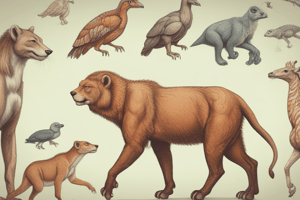Podcast
Questions and Answers
Which of the following is true about larvae?
Which of the following is true about larvae?
- They are sexually immature forms of some animals and are anatomically distinct from the adult form. (correct)
- They lack nervous and muscle tissue.
- They are always morphologically identical to the adult form.
- They are found only in plants and fungi.
What do fungi lack?
What do fungi lack?
- Autotrophic nutrition
- Nervous and muscle tissue (correct)
- Multicellularity
- Cell walls of cellulose
How do plants, fungi, and animals differ in terms of nutrition?
How do plants, fungi, and animals differ in terms of nutrition?
- Plants are heterotrophs, fungi are autotrophs, and animals are autotrophs.
- Plants and fungi are autotrophs, animals are heterotrophs.
- Plants are autotrophs, fungi are heterotrophs, and animals are heterotrophs. (correct)
- Plants and animals are autotrophs, fungi are heterotrophs.
What is the probable origin of the first true animals?
What is the probable origin of the first true animals?
What is the sequence of developmental stages from blastula to embryo?
What is the sequence of developmental stages from blastula to embryo?
Flashcards are hidden until you start studying
Study Notes
Larvae
- Larvae are the immature forms of animals that undergo metamorphosis.
- Larvae often have different feeding habits and appearances compared to adults.
Fungi
- Fungi lack chlorophyll, the pigment essential for photosynthesis.
- This means fungi cannot produce their own food and depend on external organic sources for nutrition.
Nutrition in Plants, Fungi, and Animals
- Plants are autotrophs, meaning they produce their own food through photosynthesis.
- Fungi are heterotrophs, obtaining nutrition by absorbing organic matter from their surroundings.
- Animals are heterotrophs and ingest other organisms for food.
Origin of Animals
- The first true animals likely evolved from a group of single-celled eukaryotes, specifically flagellated protists.
Development Stages
- Blastula: A hollow ball of cells formed after cleavage of a fertilized egg.
- Gastrula: A stage where the blastula invaginates, forming a two-layered embryo with an inner layer (endoderm) and an outer layer (ectoderm).
- Organogenesis: During organogenesis, the germ layers (endoderm, mesoderm, ectoderm) differentiate and form the various organs of the embryo.
- Embryo: The developing organism before birth or hatching.
Studying That Suits You
Use AI to generate personalized quizzes and flashcards to suit your learning preferences.




